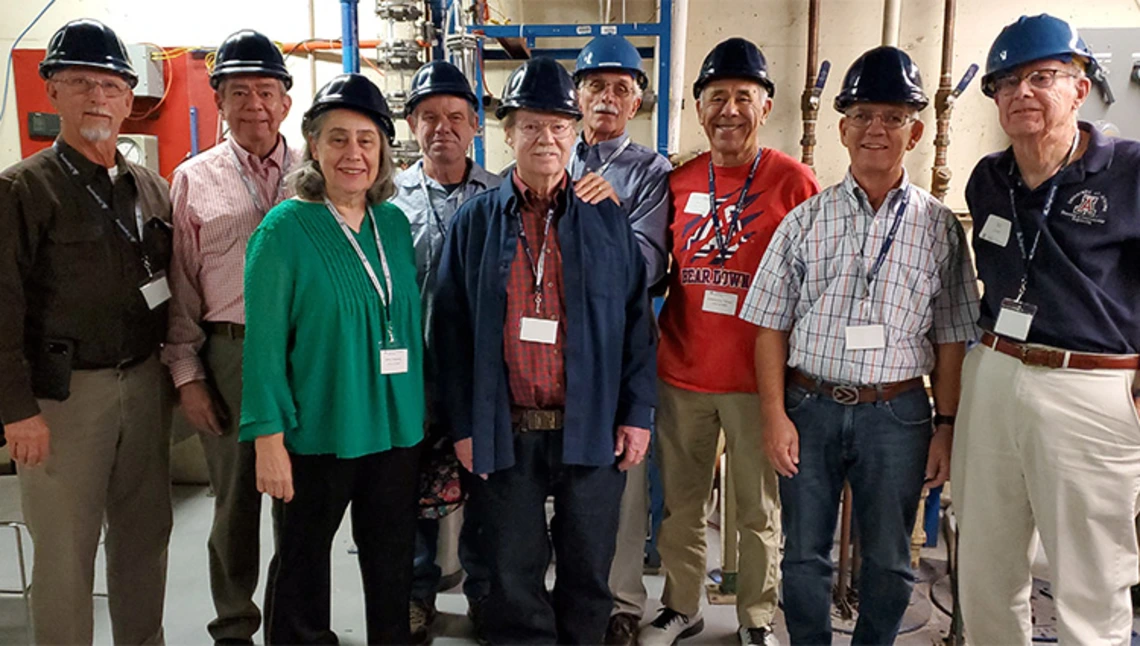Chemical Engineering Class of 1969 Reunites and Reminisces

After a long, rewarding engineering career with the U.S. Army, Paul Smith still likes to think back on his college days at the University of Arizona.
He remembers how he and his classmates regularly crashed out on the lawn, shaded by olive trees, outside the east door of the Harshbarger Building before lab. He remembers their pranks – inhaling helium in physical chemistry class to talk like Alvin and the Chipmunks, and freezing pieces of rubber with nitrogen and smashing them to bits.
But mostly he remembers how tightknit his class was, and how they supported each other through the curriculum.
“I spent many late nights with my classmates and feel we made each other better engineers,” he said.
Catching Up and Sharing Memories
Eight members of the chemical engineering Class of 1969 gathered in Tucson for a walk down memory lane – including a tour of the Harshbarger unit operations lab – on Nov. 1 during the university’s Homecoming celebration.
“The most meaningful part for me was seeing my classmates, most of whom I haven’t seen in 50 years, and reliving our experiences as undergraduates in the department,” said Ed Trujillo, a retired professor from the University of Utah and one of the half-dozen members of the Class of 1969 who attained doctorates in chemical engineering.
Mary Habeeb, the only woman in the class, went on to a career with Atlantic Richfield Co., formerly Sinclair-Koppers, in the polymers in chemicals division.
“I felt honored to share stories with my classmates and [retired associate dean and professor] Bill Cosart, and to converse with the CHEE staff, chair and students about our history and new developments in the department,” she said.
A Difficult Decision
Trujillo recalled interviewing for a summer job with Dow Chemical at a campus recruitment event during the height of the Vietnam War. A well-paying position was critical for him if he were to continue his education.
On the day of his interview, University of Arizona students staged a sit-in in front of the building, protesting the company’s manufacturing of napalm for bombs.
“I sympathized with the protesters and struggled with the decision,” said Trujillo, “but I knew this opportunity wouldn’t come again.”
He made his way through the protesters and went to work for Dow in their chlor-alkali plant in Freeport, Texas.
A Field Trip to Remember
One popular memory, shared by several reunion attendees, was a trip to Los Angeles following their second semester sophomore year. The entire class travelled by bus to visit large petrochemical sites, including Shell and ARCO refineries, as well as other chemical plants and a brewery.
The students saw reactors such as catalytic crackers, distillation trains, pumps, condensers, calandrias and heat exchangers – and they were amazed by the size of the equipment and struck by how few people it took to operate the facilities.
Nobody was sure why they got to visit the brewery, a trip highlight, but some believe it was to learn about batch processes.
“The brewery visit was painful for me,” said Smith. “I was only 19, so I couldn’t have a beer.”
Looking Back With Gratitude
The alumni who gathered for Homecoming reflected on how well their education prepared them to succeed while comparing notes on their diverse careers in industry and academia. In those days, they said, everyone in the class received multiple job offers upon graduation.
Humberto Teran, who spent his career at DuPont – at the time the largest chemical company in the world – remarked on how impressed he is with the department’s growth, and congratulated students for seeking degrees in chemical and environmental engineering.
“If I had to choose a pervading emotion from us, it is the sense of gratitude that we have for pursuing a chemical engineering degree,” he said.
